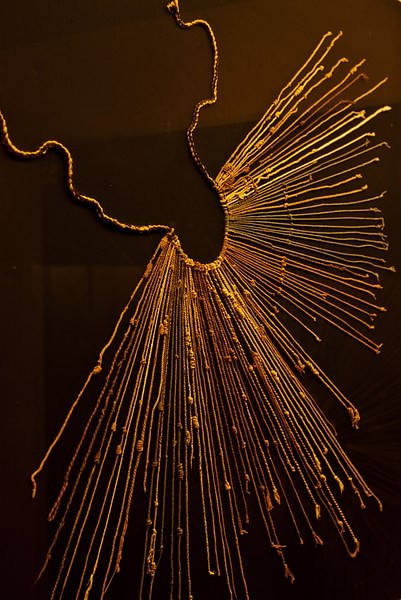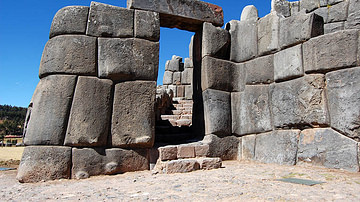
A quipu (khipu) was a method used by the Incas and other ancient Andean cultures to keep records and communicate information using string and knots. In the absence of an alphabetic writing system, this simple and highly portable device achieved a surprising degree of precision and flexibility. Quipu could record dates, statistics, accounts, and even abstract ideas. Quipu are still used today across South America.
Quipu use a wide variety of colours, strings, and sometimes several hundred knots all tied in various ways at various heights. These combinations can even represent, in abstract form, key episodes from traditional folk stories and poetry. In recent years scholars have also challenged the traditional view that quipu were merely a memory aid device and go so far as to suggest that quipu may have been progressing towards narrative records and so becoming a viable alternative to written language just when the Inca Empire collapsed.
Method
A typical quipu consists of a horizontal string or even wooden bar, from which hang any number of knotted and coloured strings made from either cotton or wool. Some of the larger quipu have as many as 1500 strings, and these could also be woven in different ways suggesting this, too, had a meaning. The various colour shades used could also carry a specific meaning. So, too, the type of knot, the position of it on the string, the total number of knots and the sequence of the knots could all combine to create a potentially huge number of meanings. The whole method was based on a decimal positional system, with the largest decimal used being 10,000. The Inca mathematical system was almost exactly the same as our own system in use today. The numbers or units in the system on a particular quipu are indicated by the strings furthest from the primary string, acting as a sort of key.
Different types of knot had different meanings. For example, a knot could indicate a number from one to nine by the turns of string within the knot, a figure-of-eight knot could indicate a fixed value, a 'granny' knot equalled ten, and a string missing a knot signified zero. Secondary strings could also hang from any single string and these could indicate that this string was an exception or of secondary importance to the other strings. Finally, individual quipu could join with others in a specific and meaningful sequence.
Naturally, to maximise the quipu's potential for information storage, it was better to have an accompanying oral record and so there grew a body of experts or masters, the khipu kamayuq (also quipucamayos). These individuals memorized the oral account which fully explained a particular quipu and, as the job was hereditary, the oral part was passed from generation to generation. There was a certain pressure attached to the job, however, as lapses in memory could be severely punished.
Purpose
At Cuzco, the Inca capital, the khipu kamayuq were professionals, and besides keeping official records using knotted cords, they also used quipu as an aide memoire to recount stories, myths and poems from the Inca tradition. Quipu were also used to record imperial conquests and royal blood-lines. They were ideal for recording the census data for provinces, i.e. total numbers, specific numbers of males and females, children, married and unmarried, etc. Other kinds of data that quipu were used to record included accounts, stores, taxes (paid in kind), livestock, land measurements, armies and their equipment, astronomy, and calendars. Quipu were also used, along with a short oral description, by Inca postal messengers (chaski).
Surviving Examples
Many ancient quipus of the Inca were purposely destroyed when Atawalpa took power and sought to clean the slate of Inca history, and, in particular, destroy the historical record concerning the reign of his bitter rival and half-brother, Waskhar. Then, following the Spanish conquest, even more quipu records were sought out and destroyed, the new rulers being highly suspicious of the information they might contain within their knots. As a result of these actions, only several hundred examples of quipu survive today. However, quipu are still used by Andean people up and down South America even today, most often by shepherds and herders as a method to record livestock numbers.






